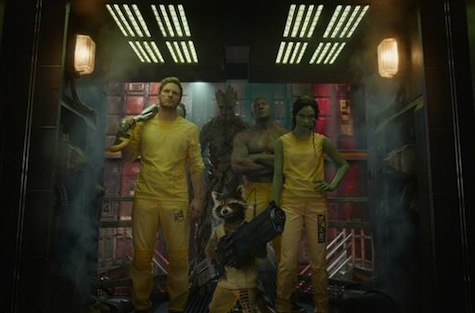I think it’s safe to say that 2014’s greatest hero is a vocabulistically-limited tree. (If not him, then maybe the raccoon with anger management issues.) I had already been think about how heroism and villainy seemed to be changing this year after I saw How to Train Your Dragon 2 and The LEGO Movie. Captain America: The Winter Soldier and X-Men: Days of Future Past also gave us far more ambiguous heroes and villains than their predecessors, and then I saw Guardians of the Galaxy.
And now, I think that the Western is evolving in some really exciting ways, especially when we look at how heroes in 2014 stack up against some of our biggest cultural good guys. Be warned: I might be completely wrong. I have accepted this, and am quite open to being yelled at in the comments. Also, spoilers abound! It turns out it’s hard to write about villain-deaths and Noble Heroic Sacrifices without giving away endings, so proceed with caution.
It wasn’t until I read Steven Zeitchik’s essay in the LA Times that I finally put everything together. Zeitchik theorizes that film has entered a post-plot age, and that since TV is providing some of the great storytelling of our era, blockbuster films have begun to coast on pure spectacle. While I certainly see that point with regards to say, Transformers and the Turtle abomination, I think that some of the most popular films of the year are far more interesting that that, because I think they’re using a new heroic paradigm.
He cites both Guardians and The LEGO Movie as examples:
In fact, “Guardians” seems to be the logical convergence point of two distinct trends that have been growing for a number of years now—in which spectacle on the one hand […] and quippy reference on the other take pride of place, effectively crowding out traditional storytelling. That Hollywood’s other major outsized success this year—“The Lego Movie”—is characterized by this same marriage seems like no coincidence…. Like “Guardians,” “Lego”[…] involved some misfits who go on the run, have lots of quippy fun and get mixed up in some big action set pieces whose actual import doesn’t matter.
I would disagree here. Guardians and The LEGO Movie are indeed a convergence of a few distinct trends, but I think Zeitchik has misidentified them. We’re post-plot because we already know all the plots. The new direction for the hero plot is to explore the theme, tone, and emotion of the journey itself. The important aspect of the hero’s journey now is to learn to communicate. The Solitary Noble Hero is being replaced, or at least supplemented, with the Fellowship of Equals. Finally, we are trying to erase the lines between “good guy” and “bad guy.”
About a thousand years ago, I wrote a paper about Tolkien, Lucas, and Rowling, and how each of them subverted the traditional hero’s quest. Nothing earth-shattering, but it does make for an interesting look at how our ideas of heroism have evolved: a typical Medieval hero went into battle alone, slew Grendel/the dragon/icky non-Christians, and possibly rescued damsels. The story ended with the death of the bad guy, often followed by the noble and sanctified death and/or religious redemption of the hero. Tolkien took these stories and chose a much different path.
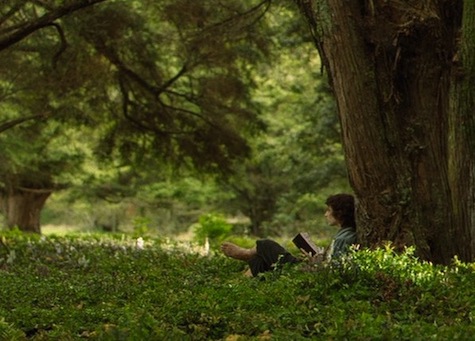
First, he gave us a hero who was completely unsuited to his quest, and a companion who was only marginally better. By working together, Frodo and Sam are able to do something that no human or elf could have done. (Tolkien even dances up to the edge of English class issues by giving Sam the credit he deserves.) What Tolkien does not do is turn the two of them into born-again warriors. They fight when they have to, but almost all of their combat is in immediate self-defense, and they ultimately win not through a battle but through a willingness to sacrifice themselves. They walk into Mordor and destroy the Ring, which is a far more difficult task. Aragorn could have slain as many orcs as he wanted to slay: as long as the Ring remained, the day would not be won.
So what is the other mark of the traditional hero? He’s a warrior, and he works alone. Whatever his Quest is, in the end it comes down to his Mighty Strength and/or Noble Sacrifice. From Beowulf to Roland to the Scarlet Pimpernel to Rick Blaine to Indiana Jones—even when there are companions, damsels, or battalions, the hero is exceptional, either by birth or by sheer hard work, he is willing to walk into danger. He is willing to lead. After his horrific experiences in World War I, Tolkien took a slightly different tack.
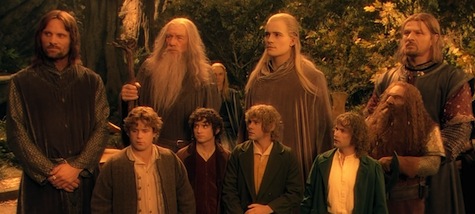
Quick, who’s the leader of the Fellowship? Is it Aragorn, the man who was born to be King? Because, as stated above, his warrior shtick doesn’t matter if the One Ring survives. Is it Gandalf, the wise and powerful Wizard? Cause he, um, dies at a certain point, and the Fellowship continues without him. Is it Frodo, Ringbearer? Wellll…Frodo leaves halfway through the quest, and has a completely different adventure with Sam. Each of the components of the fellowship was vital to its success. The Hobbits may bow to no one, but the Fellowship is made up of equals, even poor fallen Boromir. (He’s your stalwart White Protestant-ish dude, by the way, who, in a normal story, would be the one slaying the dragon at the end.)
There’s a reason LOTR caught on in America when it did, after all—a lot of American kids and countercultural-type people were fed up with the whitebread hero saving the world with his fists. This Fellowship model was another obvious influence on Star Wars and Harry Potter: Luke may have to face his father alone, but much of his heroic work is done in tandem with Leia, Han, Chewy, and even Lando, and Harry Potter wouldn’t have made it as a hero without Hermione, Ron, and alternate-universe hero Neville.
So if we’ve already shifted from expecting a Noble (violent and solitary) Hero to a group of talented people who might use non-violent means to succeed, what’s the next step for the Western Hero? The newest shift seems to be happening now, the first big step in heroic writing that we’ve had since Tolkien. And its building on the stuff that came before it, but I think it’s pushing us in a new direction. Maybe even a new way to classify heroism itself.
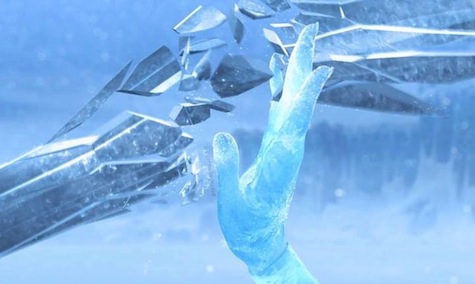
Frozen revolves around two hero quests: Elsa’s journey to understand and control her powers, and Anna’s rescue mission after Elsa runs away. So here we have an internal struggle and a traditional search. Anna is the one who makes the Noble Sacrifice—saving Elsa, defeating Hans, and lifting her curse all in one fell swoop. (Anna is the most efficient hero.) And it is Elsa’s love for her sister that allows her to use all of her powers, and restore warmth to the Queendom.
The two villains, Hans and the Duke of Weselton, don’t matter very much. Hans’ treachery is horrible (“Aw, Anna! If only somebody loved you.” Shudder. Shudder forever.), but in the end, Anna’s right. He isn’t a match for Elsa. He’s no match for Anna, either. Elsa defends herself quite capably from the Duke’s goons (but without becoming a “monster”) and the Duke himself is thrown out of Arendelle by unnamed guards.
Usually we get a violent confrontation between hero and villain while the helpless princess looks on (Beast vs. Gaston, Eric vs. Ursula, Philip vs. Maleficent, Simba vs. Scar, etc.). Here the “helpless” princess, Anna, rejects Kristoff’s offer of True Love’s Kiss to save the apparent villain, Elsa, from the actual villain, Hans. The True Love between the sisters is so powerful that it defeats Hans’ physical strength and Elsa’s magic, and lets the film sidestep the violent climax entirely, while subverting the audience’s expectations of what heroism looks like.
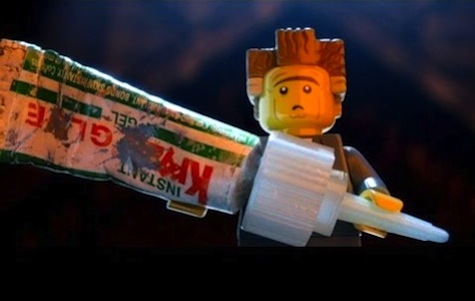
The LEGO Movie hangs a lampshade on its archetypes. There are grand old wizards, Master Builders, The Special, the Piece of Resistance, and Evil Lords. At one point everyone thinks Emmett Brickowski is The Special, but he doesn’t even want to be The Special, he just wants to have friends so he can hang out on his double-decker bunk-couch and watch TV with them. Then he’s briefly the Plucky Young Man Who Believes in Himself So Hard He Becomes a Hero. Finally, he becomes the Noble Self-Sacrificing Hero, and dies for his friends. And under the old paradigm, either WyldStyle would take up the baton and lead them to victory, or Emmett would come back changed into some sort of superbeing who could defeat Lord Business with a touch of his hand.
Instead, Emmett returns to his life with his normal amount of strength and mortality, but with a new perspective on his life and world. Instead of suddenly being able to defeat Lord Business, he just goes up and talks to him. He says the exact thing that all of us wanted to say to dumb bad guys in dumb movies when we were kids:
You don’t have to be the bad guy. You are the most talented, most interesting, and most extraordinary person in the universe. And you are capable of amazing things. Because you are the Special. And so am I. And so is everyone. The prophecy is made up, but it’s also true. It’s about all of us. Right now, it’s about you. And you… still… can change everything.
And Lord Business listens to him, considers what he says, and changes his mind. When was the last time you saw a villain change his mind on camera? And as if that isn’t enough, there’s a hug.
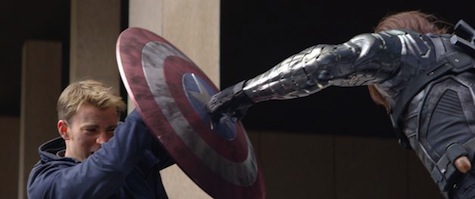
This year was pretty well saturated with Marvel characters. While Captain America: The First Avenger ends with a giant battle with Red Skull and the Noble Solo Sacrifice of Steve Rodgers, The Winter Soldier makes Cap part of a team of equals, and gives each of them a vital role in saving the world from Alexander Pierce. It’s Widow who makes the big Sacrifice play. Steve misses the big showdown completely, because he’s busy trying to work shit out with Bucky. The most American of heroes puts his friendship before everything else.
We can compare the endings of X-Men: First Class and Days of Future Past in the same way. First Class culminates in a violent showdown that leaves Charles Xavier paralyzed, Sebastian Shaw dead, and Eric firmly on the villain side of the hero/villain spectrum. Days of Future Past sets us up for a similar ending: Charles vs. Eric vs. Trask/Nixon vs. Mystique, with Sentinels mowing down mutants in the future, and Wolverine chained at the bottom of the Potomac. Mystique, having already rejected the Noble Sacrifice that Eric wanted her to make, now rejects the violence Trask and Charles both expect from her. She wounds Eric, disables the Sentinels, shows the President that Mutants are A-OK, and saves the future. Like Anna, Mystique is also an efficient hero.
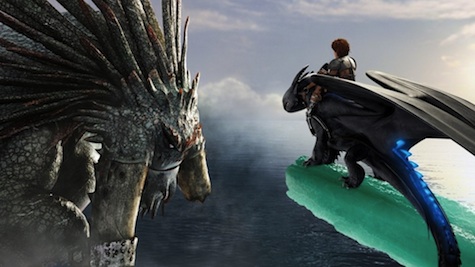
How to Train Your Dragon 2 is about Hiccup and Toothless’ shared hero quest. Of all the heroes in these films, Hiccup is the most determined to seek communication with others. He never resorts to violence, and not even because he’s small for a Viking: he genuinely believes that talking to your enemies and finding empathy for them will solve all problems. It worked with Toothless and his father in the first film, but here it fails in a sense—when Hiccup encounters Drago, he finally meets a man who won’t listen to anything he has to say. However, Hiccup’s talent for communication is rewarded elsewhere in the film, as he can speak to new dragons, and eventually helps convert a pirate over to the dragon-loving side.
His talent for empathy is also what converts this from being a standard heroic bildungsroman into something new. At the center of the film, there is a horrible moment, the type of thing that defines a hero. Toothless, as a young dragon, falls under the mental power of the Alpha, a much more powerful dragon, who is in turn controlled by Drago. Drago turns Toothless against Hiccup, and in the ensuing blast of fire Stoick dies saving his son. Drago takes Toothless and leaves to invade Berk. At this point Hiccup has to make a choice. He can condemn the dragon, and become as bitter and hateful as Drago himself, or he can forgive Toothless and trust that their friendship is stronger than Drago’s will. By making the second choice he becomes the man who can take his father’s place as leader of Berk. When Hiccup is asked about his plan, he replies that he’s going back to Berk to rescue Toothless, and kick Drago’s ass. What actually happens is that he and Toothless rescue each other, and Toothless bypasses Drago entirely to challenge the Alpha. Both human villainy and heroics are rendered irrelevant as the dragons battle for supremacy. Hiccup can’t be the Noble Hero, because his world is too complicated.
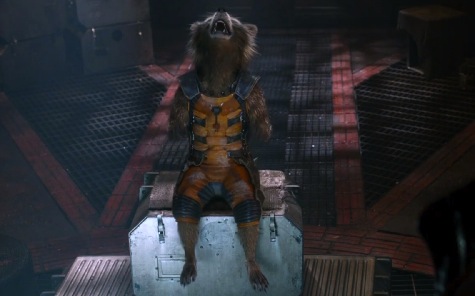
So, what sort of heroes is Guardians giving us, and why are they so popular? If we look at the Avengers, we see a cartoonishly moral supersoldier, a genius billionaire playboy philanthropist, a top physicist/green rage monster, the world’s greatest spy, the world’s other greatest spy, and a Norse god. What do we see in the Guardians? They’re bad at everything they do. They’re not even particularly competent at their lowlife jobs at the beginning of the film. Quill is doing his best to be a devil-may-care thief, but Indiana Jones he is not. He gets caught stealing artifacts, gets his ass kicked by Gamora, and when he does manage to act heroically, he has to ruin everything by pointing it out. When the time comes for him to step up and give a rousing Hero Speech, the best he can come up with is “Life’s giving us a chance to give a shit.” (Not to save the galaxy, but simply to care about it. That’s a fairly low bar to set for hero-ing.) Drax fucks up his attempt at Lone Noble Dude-hood, Gamora doesn’t have the heart to be a cold-blooded assassin, Rocket’s a walking wound, and Groot…well, Groot’s perfect. But also, not a natural heavy.
As a film, The Avengers had a solid plot—Loki steals the tesseract, tries to invade earth, the Avengers gradually assemble and stop him. There’s some trickery, some reversals, a catalytic death, and then Loki’s plan is thwarted and shawarma is had by all. Pretty straight forward, and the film begins this plot immediately. The first thing we see is Loki stealing the tesseract and brainwashing Hawkeye, and then everything unfolds (relatively) logically from there.
Guardians, though, doesn’t seem to care about its plot. As the film begins, the first sound we hear is pop and hiss of tape unspooling (Actually, I didn’t so much hear it as feel it, the almost subliminal click in the back of my brain, as the tape started to move.) and we see the once and future Star-Lord listening to 10cc’s “I’m Not In Love” while his mother dies in the other room. From here we have a film that jumps in time, hops from planet to planet, and careens through a wide range of emotions with little regard for whether we can keep up. James Gunn is trusting us to care enough about the characters that we’ll accept an emotional hero’s quest rather than a traditional plot-driven one. After starting with that raw opening scene, we return again and again to Gamora’s murdered family, Drax’s murdered family, the torture inflicted on Rocket, Ronan’s religious war, the terrified people of Nova City, Groot’s essential solitude. The real story is how each of these people come to terms with their pasts, and find a new type of heroism by joining together.
Best of all, it’s made clear at the end that they don’t reform. They don’t have any kind of epiphany. No one discovers some untapped potential. No one realizes that The Power Was Inside Them, All Along. They are only capable of becoming what they become through working together. The group bonds over a shared sense of loss, Drax apologizes for challenging Ronan, Gamora stops insulting Rocket, Quill puts Gamora’s life before his own (sort of), they accept each other for who they are, and become a true team. The Avengers choose to be a team, because their strength combined is extraordinary. The Guardians have to be a team, because their combined strength is what makes them heroes. And again, who’s the leader?
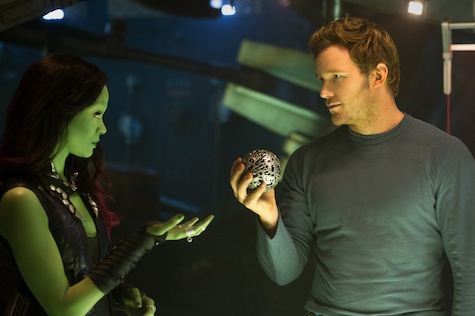
Is it Quill? ’Cause Gamora’s the one who insists they give the stone to Nova. And Drax is the one who shoots Nebula. And it’s Groot who saves them when the ship crashes. But Rocket’s the one who actually knocks the stone out with his super-gun. Although he’s only able to build the gun because Quill distracts Ronan.
Guardians establishes a round robin of heroism throughout their battles, and then pays it off in the two climactic scenes at the end. First, as the ship crashes, Groot wraps the rest of his group (his fellowship) into his branches, and names them all Groot. They are not just his family, they are part of him. When was the last time a true action film made time for that kind of statement? But that isn’t even the only one. After Groot’s sacrifice, the group reconvenes for the last attempt. Quill does the Noble Hero thing, and dives to catch the infinity stone, knowing that it will kill him. But not only does he live, his three remaining friends hold onto him to help bear the weight of the stone, and with their combined strength, they’re able to wield the stone against Ronan. We are Groot. We are the Guardians of the Galaxy.
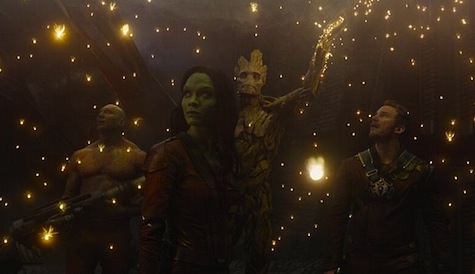
But these films don’t stop with simply giving us a team of heroes rather than a single one: they also give us new types of villains. In Frozen the sisters’ real battle is to form a better relationship with each other, and the efforts of the villains don’t matter much. Compare the Duke of Weselton’s thugs with Gaston. Compare Hans with Ursula, or Cruella de Ville. They’re inconsequential. In Days of Future Past, Eric is not exactly a villain (he has some uncomfortably astute points about human/mutant relations…) and Trask is defeated through a public act of non-violence. In Dragon 2 Toothless commits the most “villainous” act, and is forgiven. Drago, meanwhile, actually gets a chance to explain his side. In The LEGO Movie the bad guy learns that he, too, is the Special, and decides to stop being the bad guy.
And in Guardians, Ronan and Nebula both have legitimate grievances. I’ll agree with many critics that the film doesn’t spend quite enough time with them, but these are not cardboard cut-out villains. The only things that make them “bad” is that none of them can see past their own personal pain. They want to inflict their losses and fear on the world, and ultimately it’s this failure of empathy that makes them villains.
So what does all this mean, if anything? Are we moving into an era of the non-binary hero quest, where heroes and villains are not so easily defined? Where communication and fellowship are valued over brute force? Where the people we thought were our greatest enemies turn out to be just as Special as us?
Leah Schnelbach always seems to sympathize with the bad guys. She’s making a heroic effort to Tweet more!










